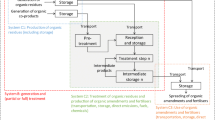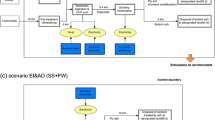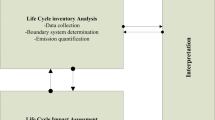Abstract
Purpose
The benefits and environmental burden of two different strategies (incineration vs anaerobic digestion followed by composting) to manage the organic fraction of municipal solid waste were assessed. Particular attention was also focused on system components, including collection, treatment, facility construction, and disposal, as well as the effect of the energetic context. Source segregation intensities considered for the scenario with incineration and with anaerobic digestion followed by composting were respectively of 0 and 52 %.
Methods
The analysis was performed by an LCA approach, and the impact was assessed by the CML method. The functional unit was a single ton of organic waste generated in the area considered. System boundaries were expanded to include the differences in waste collection and multi-functionality waste treatments. Existing databases were retrieved, also adopting experimental data for the waste management area considered.
Results and discussion
Overall, the scenario with the highest rate of source segregation of organic waste, using anaerobic digestion followed by composting, gave a lower impact for human and terrestrial toxicity. Concerning the other impacts, incineration gave the maximum benefits. The impact of anaerobic digestion and composting arises mainly from energy consumption, greenhouse gas emissions (i.e., N2O, VOC), and landfilling of residues. The sensitivity analysis performed by varying the energetic mix of the context confirmed the advantages of incineration of the organic fraction.
Conclusions
Incineration of organic waste leads to maximum environmental benefits compared to anaerobic digestion and composting. Furthermore, anaerobic digestion and composting was characterized by high gaseous emissions with high greenhouse gas potential even if the production of organic fertilizer gave some benefits concerning the avoided exploitation of mineral resources. The impact due to the collection phase and facility construction was quite limited and in some cases negligible.



Similar content being viewed by others
References
Antonopoulos LS, Karagiannidis A, Tsatsarelis T, Perkoulidis G (2013) Applying waste management scenarios in the Peoloponnese region in Greece: a critical analysis in the frame of life cycle assessment. Environ Sci Pollut Res 20:2499–2511
Assamoi B, Lawryshyn Y (2012) The environmental comparison of landfilling vs. incineration of MSW accounting for waste diversion. Waste Manag 32:1019–1030
Blengini GA (2008) Using LCA to evaluate impacts and resource conservation potential of composting: a case study of the Asti District in Italy. Resour Conserv Recycl 52:1373–1381
Blengini GA, Busto M, Fantoni M, Fino D (2012) Eco-efficient waste glass recycling: Integrated waste management and green product development through LCA. Waste Manag 32:1000–1008
Bolzonella D, Pavan P, Mace S, Cecchi P (2006) Dry anaerobic digestion of different sorted organic municipal solid waste: a full scale experience. Water Sci Technol 53:23–32
Buttol P, Masoni P, Bonoli A, Goldoni S, Belladonna V, Cavazzuti C (2007) LCA of integrated MSW management systems: case study of the Bologna District. Waste Manag 27:1059–1070
Cherubini F, Bargigli S, Ulgiati S (2009) Life cycle assessment (LCA) of waste management strategies: landfilling, sorting plant and incineration. Energy 34:2116–2123
CML (2001) Bureau B&G, school of systems engineering, policy analysis and management – Delft University of Technology, 2001. Life Cycle Assessment: An Operational Guide to the ISO Standards
De Baere L, Mattheeuws B (2010) Anaerobic digestion in Europe: state of the art 2010. In: ORBIT 2010, Heraklion
Di Maria F (2012) Upgrading of a Mechanical Biological Treatment (MBT) plant with a Solid Anaerobic Digestion Batch: A Real Case Study. Waste Manag Res 30: 1089–1094
Di Maria F, Micale C (2013) Impact of source segregation intensity of solid waste on fuel consumption and collection costs. Waste Manag 33:2170–2176
Di Maria F, Micale C (2014) A holistic life cycle analysis of waste management scenarios at increasing source segregation intensity: the case of an Italian urban area. Waste Manag 34:2382–2392
Di Maria F, Sordi A, Micale C (2013a) Experimental and life cycle analysis of gas emissions from mechanically-biologically pretreated waste in landfill with energy recovery. Waste Manag 33:2557–2567
Di Maria F, Gigliotti G, Sordi A, Micale C, Zadra C, Massaccesi L (2013b) Hybrid solid anaerobic digestion batch: biomethane production and mass recovery from the organic fraction of solid waste. Waste Manag Res 31:869–873
Dogan K, Duleyman S (2003) Cost and financing of municipal solid waste collection service in Istanbul. Waste Manag Res 21:480–485
Energynet (2012) Environmental report for Danish electricity and CHP. 2012. https://www.energinet.dk/SiteCollectionDocuments/Engelske%20dokumenter/Klimaogmiljo/Environmental%20report%20for%20Danish%20electricity%20and%20CHP%20-%20summary%20of%20the%20status%20year%202012.pdf. Accessed Jun 2014
European Commission (2010) Joint Research Centre - Institute for Environment and Sustainability and DG Environment - Directorate G. 2008: European Reference Life Cycle Database, version 2.0. http://eplca.jrc.ec.europa.eu/. Accessed 26 May 2014
European Commission (EC) (2008) – Joint Research Centre – Institute for Environmental and Sustainability. 2010. International Reference Life Cycle Data System (ILCD) Handbook – General guide for Life Cycle Assessment – Detailed guidance. First edition March 2010. EUR 24708 EN. Publications Office of the European Union. Luxembourg
Hischier R, Weidema B, Althaus HJ, Bauer C, Doka G, Dones R, Frischknecht R, Hellweg S, Humbert S, Jungbluth N, Kollner T, Loerincik Y, Margni M, Nemecek T (2010) Implementation of Life Cycle Impact Assessment Methods. Econivent report N°3, v2.1. Swiss Centre for Life Cycle Inventories, Dubendorf
Iriarte A, Gabarrell X, Rieradevall J (2009) LCA of selective waste collection system in dense urban areas. Waste Manag 29:903–914
ISO 14040 (2006) Environmental management: life cycle assessment, principles and guidelines. International Organization of Standardization, Geneva
Khoo HH, Lim TZ, Tan RBH (2010) Food waste conversion options in Singapore: environmental impacts based on an LCA perspective. Sci Total Environ 408:1367–1373
Laurent A, Bakas I, Clevereul J, Bernstad A, Niero M, Gentil E, Hauschild MZ, Christensen TH (2014a) Review of LCA studies of solid waste management systems—part I: lesson learned and perspective. Waste Manag 34:573–588
Laurent A, Bakas I, Clevereul J, Bernstad A, Niero M, Gentil E, Hauschild MZ, Christensen TH (2014b) Review of LCA studies of solid waste management systems—part II: methodological guidance. Waste Manag 34:589–606
Linzner R, Mostbauer P (2005) Composting and its impact on climate change with regard to process engineering and compost application – a case study in Vienna. In: Proceedings of Sardinia, Tenth International Landfill Symposium. Cagliari: CISA Publisher
Prè Consultants (2013) SimaPro8 Prè consultants BV, Amersfoort, The Netherlands; 2013. Available on line at <www.pre-sustainability.com/download/All-About-SimaPro8-oct-2013.pdf. Accessed Jan 2014
Rico C, Rico JL, Tejero I, Munoz N, Gomex B (2011) Anaerobic digestion of the liquid fraction of dairy manure in pilot plant for biogas production: residual methane yield of digestate. Waste Manag 31:2167–2173
Rigamonti L, Falbo A, Grosso M (2013) Improvement actions in waste management systems at the provincial scale based on a life cycle assessment evaluation. Waste Manag 33:2568–2578
Sonesson U, Bjorklund A, Carlsson M, Dalemo M (2000) Environmental and economic analysis of management systems for biodegradable waste. Resour Conserv Recycl 28:29–53
TERNA (2013) Dati statistici sull’energia elettrica in Italia; 2013. Available on line at http://www.terna.it/LinkClick.aspx?fileticket=8fzKlKgsmzY%3D&tabid=418&mid=2501. Accessed Jun 2014
Tillmann DA (1991) The combustion of solid fuels and waste. Academic, San Diego, CA. ISBN 0-12-691255-6
Turconi R, Butera S, Boldrin A, Grosso M, Rigamonti L, Astrup T (2011) Life cycle assessment of waste incineration in Denmark and Italy using two LCA models. Waste Manag Res 29:78–90
Valerio F (2010) Environmental impacts of post-consumer material managements: recycling, biological treatments, incineration. Waste Manag 30:2354–2361
Author information
Authors and Affiliations
Corresponding author
Additional information
Responsible editor: Shabbir Gheewala
Rights and permissions
About this article
Cite this article
Di Maria, F., Micale, C. Life cycle analysis of incineration compared to anaerobic digestion followed by composting for managing organic waste: the influence of system components for an Italian district. Int J Life Cycle Assess 20, 377–388 (2015). https://doi.org/10.1007/s11367-014-0833-z
Received:
Accepted:
Published:
Issue Date:
DOI: https://doi.org/10.1007/s11367-014-0833-z




